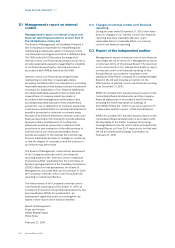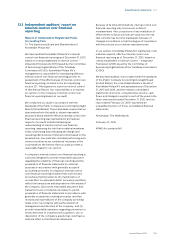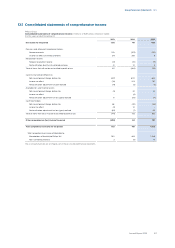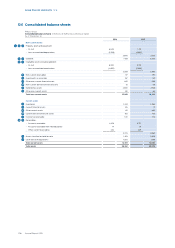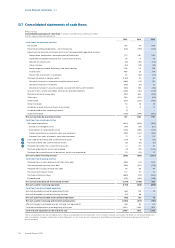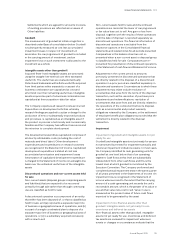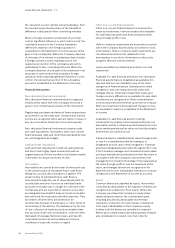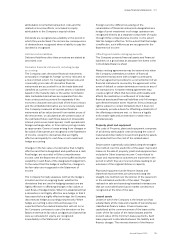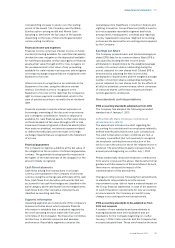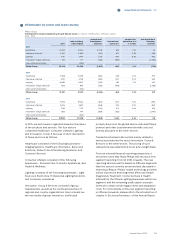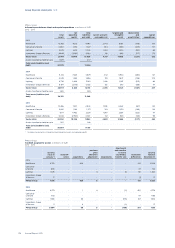Philips 2015 Annual Report Download - page 114
Download and view the complete annual report
Please find page 114 of the 2015 Philips annual report below. You can navigate through the pages in the report by either clicking on the pages listed below, or by using the keyword search tool below to find specific information within the annual report.Group nancial statements 12.9
114 Annual Report 2015
a percentage of sales or a xed amount per product
sold, is recognized on an accrual basis based on actual
or reliably estimated sales made by the licensees.
Grants from the government are recognized at their fair
value where there is a reasonable assurance that the
grant will be received and the Company will comply
with all attached conditions. Government grants
relating to costs are deferred and recognized in the
Statement of income over the period necessary to
match them with the costs that they are intended to
compensate.
Income tax
Income tax comprises current and deferred tax. Income
tax is recognized in the Statement of income except to
the extent that it relates to items recognized directly
within equity or in other comprehensive income.
Current tax is the expected tax payable on the taxable
income for the year, using tax rates enacted or
substantially-enacted at the reporting date, and any
adjustment to tax payable in respect of previous years.
Deferred tax assets and liabilities are recognized, using
the balance sheet method, for the expected tax
consequences of temporary dierences between the
carrying amounts of assets and liabilities and the
amounts used for taxation purposes. Deferred tax is not
recognized for the following temporary dierences: the
initial recognition of goodwill, the initial recognition of
assets and liabilities in a transaction that is not a
business combination and that aects neither
accounting nor taxable prot, and dierences relating
to investments in subsidiaries to the extent that they
probably will not reverse in the foreseeable future.
Deferred tax is measured at the tax rates that are
expected to be applied to temporary dierences when
they reverse, based on the laws that have been enacted
or substantially-enacted by the reporting date.
Deferred tax assets and liabilities are oset if there is a
legally-enforceable right to oset current tax liabilities
and assets, and they relate to income taxes levied by
the same tax authority on the same taxable entity or on
dierent tax entities, but they intend to settle current
tax liabilities and assets on a net basis or their tax assets
and liabilities will be realized simultaneously.
A deferred tax asset is recognized for unused tax losses,
tax credits and deductible temporary dierences, to the
extent that it is probable that future taxable prots will
be available against which they can be utilized. The
ultimate realization of deferred tax assets is dependent
upon the generation of future taxable income in the
countries where the deferred tax assets originated and
during the periods when the deferred tax assets
become deductible. Management considers the
scheduled reversal of deferred tax liabilities, projected
future taxable income and tax planning strategies in
making this assessment.
Deferred tax liabilities for withholding taxes are
recognized for subsidiaries in situations where the
income is to be paid out as dividend in the foreseeable
future and for undistributed earnings of unconsolidated
companies to the extent that these withholding taxes
are not expected to be refundable or deductible.
Changes in tax rates are reected in the period when
the change has been enacted or substantially-enacted
by the reporting date.
Provisions
Provisions are recognized if, as a result of a past event,
the Company has a present legal or constructive
obligation that can be estimated reliably, and it is
probable that an outow of economic benets will be
required to settle the obligation. Provisions are
measured at the present value of the expenditures
expected to be required to settle the obligation using a
pre-tax discount rate that reects current market
assessments of the time value of money. The increase
in the provision due to passage of time is recognized as
interest expense. The accounting and presentation for
some of the Company’s provisions is as follows:
• Product warranty – A provision for warranties is
recognized when the underlying products or services
are sold. The provision is based on historical warranty
data and a weighing of possible outcomes against
their associated probabilities.
• Environmental provisions – Measurement of
liabilities associated with environmental obligations,
is based on current legal and constructive
requirements. Liabilities and expected insurance
recoveries, if any, are recorded separately. The
carrying amount of environmental liabilities is
regularly reviewed and adjusted for new facts and
changes in law.
• Restructuring-related provisions – The provision for
restructuring relates to the estimated costs of
initiated restructurings, the most signicant of which
have been approved by the Executive Committee,
and which generally involve the realignment of
certain parts of the industrial and commercial
organization. When such restructurings require
discontinuance and/or closure of lines of activities,
the anticipated costs of closure or discontinuance are
included in restructuring provisions. A liability is
recognized for those costs only when the Company
has a detailed formal plan for the restructuring and
has raised a valid expectation with those aected
that it will carry out the restructuring by starting to
implement that plan or announcing its main features
to those aected by it. Before a provision is
established, the Company recognizes any
impairment loss on the assets associated with the
restructuring.
• Litigation provisions – In relation to legal claim
provisions and settlements, the relevant balances are
transferred to Other liabilities at the point the amount
and timing of cash outows are no longer uncertain.


